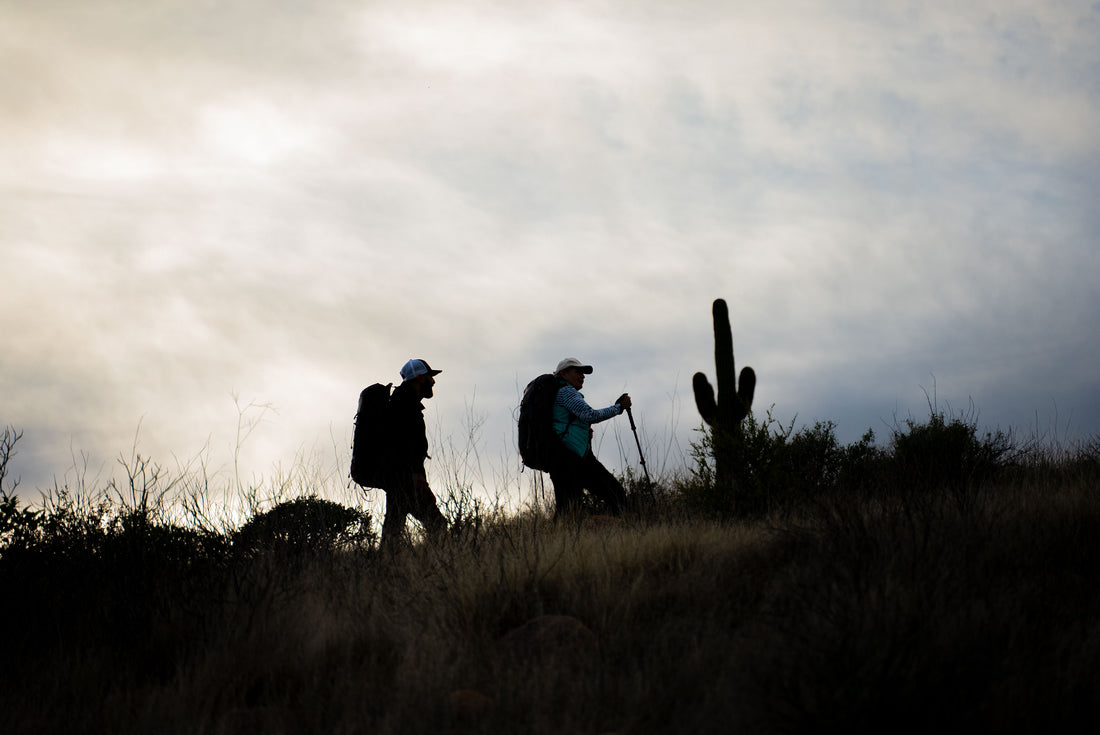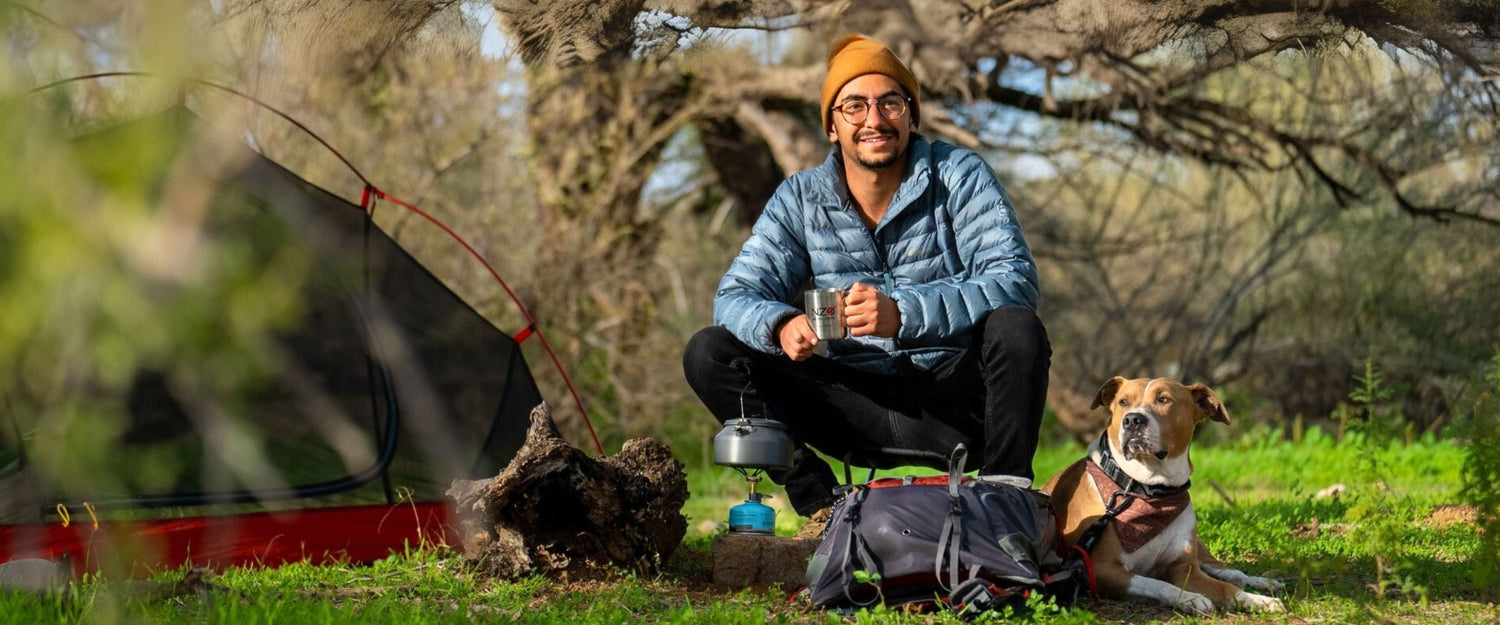
Survival 101: Fundamental Skills for the Wild
Do you have a friend who feels uncomfortable going camping because they don't know what they'll need or are afraid something bad may happen and they may not know what to do? Then, this blog is for them.
When it comes to gear, Near Zero is their one-stop shop for all they'd need for a camping or backpacking trip. Our bundles take that guesswork away, and we pack it for them!
When it comes to some basic survival skills, these are the top we think someone should master or have at least practiced before trying their hand at camping alone or without someone who has outdoor experience.
Starting a fire and fire safety
If you can start a fire, keeping yourself warm and cooking food will be easy. Understanding fire safety will prevent you from burning yourself or the environment, which can be dangerous.
The basics
- Gather three types of wood: tinder (twigs, dry leaves, grass, etc.), kindling (sticks that are less than an inch thick), and fuel (large pieces of wood).
- Place your tinder loosely in the center of the pit.
- Ignite your tinder with a match or lighter.
- As the tinder glows, blow on it to create a flame. Then, add kindling and fuel to make your fire larger.
- BE SURE TO KEEP WATER NEARBY TO PUT OUT YOUR FIRE!
Building a shelter
Knowing how to build a shelter can keep you dry and safe. Camping will be easier with a tent, but if you ever need to make one, here are some basics.
The Basics
- Find a fallen tree, ledge, or a large rock in a dry area away from harmful plants.
- Gather dry leaves, pine needles, and bark and build a pile 2-3 feet high and longer than you are tall in the place where you plan to lie down.
- If you find a fallen tree, use the branches as a sort of wall. If it has enough room for you to crawl into, you've found yourself a prime location! Use long sticks and lay them against the fallen tree branches to keep the wind out.
- If you find a rock or ledge, you can build a "lean-to." Like your tree wall, lean large sticks against the boulder. Once it's in a good place, crawl under your sticks and get cozy.
Identifying edible plants and good water sources
Near Zero sells excellent water filters, but if you forget them (you should've used your backpacking checklist), we don't want you to get dehydrated. And if you get hungry and are tempted to eat some unknown berries, we want you to be able to identify if they are edible before you ruin your adventure even further.
The Basics
- The traits of a poisonous plant are milky saps, fine hairs and spines, umbrella-shaped flower clusters, waxy leaves, and mushrooms.
- The traits of edible plants: Rule out the traits above, rub the plant on your lip, and see if you have a reaction. If you don't, give it a small taste test and wait five minutes. If the berry has no bitter or soapy flavor, chew for a minute and spit out any extra saliva regularly for eight hours. If you have no reactions on a second round of a small taste, it may be safe to eat.
- The higher up the water table you go is where you'll find the purest water. If you are unsure if your water is safe, light a fire and boil it to kill the contaminants.
Navigation
If you can't read a map or compass, practice before you go out into the great outdoors. Your cell phone may lose service, so knowing where you're going without it could save your life.
The Basics
- Hold the compass in front of you so the arrow faces where you're walking. Then, rotate the compass so the red line aligns with the N.
- The sun rises in the east and sets in the west.
- If you have a map, look at the wilderness around you and see where it aligns on the map. Then, use the compass steps we shared to find your heading.
Pack the right gear
If you're shopping at Near Zero, you're in the right place! However, we encourage you to test out the gear before you take it with you. You will also need to bring the right clothes to prepare for any weather.
The Basics
- Near Zero's packing checklist is a great place to start if you want to ensure you're taking all the right gear.
- Check the weather before you go and pack appropriate clothes. Always bring extra socks; wet feet can lead to illness or make walking uncomfortable.
Wildlife awareness
Not only is your food food for wildlife, but you may be too!
The Basics
- When you're not eating, keep your food away from you in a locked box or high in a tree away from camp.
- Don't approach wildlife with food. They might attack or bite you.
- Make noise! If your family told you not to sing in the shower, now is the time to use that voice to keep animals away from your site. Noise will also help because you want to avoid surprising an animal.
- If you encounter these animals:
- Bears - Do not run or climb a tree. Talk quietly, wave your arms above your head, and make yourself appear as large as possible. If the bear stays still, walk sideways until you're safe. If it charges you, play dead by lying face down with your elbows over your face and your hands across your neck.
- Moose - Stay calm and don't run away. Talk to the moose and slowly back away in the direction you came while facing the moose.
Basic first aid
Knowing how to treat injuries, whether big or small, can make a difference in an emergency. Our First Aid Kit has many essentials; however, knowing how to perform basic CPR, the Heimlich maneuver, or treat allergic reactions can help you be ready.
The Basics
- Stop bleeding: If someone has cut a main artery or vein, knowing how to stop the bleeding could save their lives.
- Burn treatment: For first-degree burns, run them under cool water. Second and third-degree burns need to be treated by a doctor.
- Setting a splint: Setting a broken bone can relieve pain and avoid further damage. Use a stick or some clothing to create one while you prepare to see a doctor if necessary.
- Sprains: These should be wrapped with an ACE bandage and treated with RICE—rest, ice, compression, and elevation.
Be prepared when you go camping! Be prepared with knowledge so your adventure doesn't turn into a nightmare. Our gear is made so you can feel prepared for whatever may happen on your first or your 100th adventure, but we also want you to be ready for when the unexpected happens, so when an emergency occurs, you know what to do.


1 comment
I look forward to reading more of your articles. Like these they are very good.